ICDs
Medically Reviewed by Prabal K. Guha, MD
The Implantable Cardioverter Defibrillator or ICD can bring extra years of life to certain heart patients by essentially shocking their heart back into action if they stop.
HOW IT WORKS
“The battery-powered device (about the size of box of Tic-Tac mints) is inserted under the skin and monitors the patient’s heart,” says McLeod Electrophysiologist Dr. Prabal Guha. “If the ICD detects an abnormal heart rhythm – too fast or erratic — it delivers electrical pulses or a shock, restoring a normal heart beat.”
WHO NEEDS IT
Your Cardiologist or Electrophysiologist may suggest an ICD if the ventricular rhythm (heart’s lower chamber) threatens your life as the result of:
- A heart attack or sudden cardiac arrest,
- A congenital heart problem or condition that could cause a sudden cardiac arrest or
- Several other cardiac issues, including Brugada Syndrome and Long QT Syndrome.
If you have one of the above conditions, a cardiologist will start a series of tests to identify and isolate your risk, including:
- Electrocardiogram (EKG), showing the pattern and rate of your heartbeat. Most EKGs are performed in an office setting. However, some patients may be asked to wear a portable EKG.
- Wearable Monitors, tracking your heart rate for periods from one day to a month or two.
- Echocardiogram, using sound waves to create a picture of your heart (similar to the way an ultrasound enables a physician and parents to see a baby during pregnancy).
- Electrophysiology study, studying the heart by threading a thin wire to your heart and recording the electrical impulses.
- Stress test, hooking your heart up to monitors and recording your heart while you walk or jog.
Forty percent of ICD patients are age 70 or older and about ten percent are aged 80 or older. The older the patient the poorer the survival rate, probably due to additional health issues the older patient might have.
ACTION YOU CAN TAKE
If your medical condition requires an ICD, it’s important that you stay active. A study in the Journal of the American Medical Association found that the most active ICD patients tended to live longer. Activity, as simple as walking, ranged from 30-minutes a day on the low side to 3 hours a day on the high side. After four years, 90% of patients recording the highest level of activity were still living, about twice the number of those who had low levels of activity.
Sources include: McLeod Health, American Hospital Association, American Heart Association, Journal of the American Medical Association, Circulation: Cardiovascular Quality & Outcomes, National Institutes of Health, British Heart Foundation
-
McLEOD REGIONAL MEDICAL CENTER FLORENCE
843-777-2000 -
McLEOD DARLINGTON
843-777-1100 -
McLEOD DILLON
843-774-4111 -
McLEOD LORIS
843-716-7000 -
McLEOD SEACOAST
843-390-8100 -
McLEOD CHERAW
843-537-7881 -
McLEOD CLARENDON
803-433-3000



-
McLEOD REGIONAL MEDICAL CENTER FLORENCE
843-777-2000 -
McLEOD DARLINGTON
843-777-1100 -
McLEOD DILLON
843-774-4111 -
McLEOD LORIS
843-716-7000 -
McLEOD SEACOAST
843-390-8100 -
McLEOD CHERAW
843-537-7881 -
McLEOD CLARENDON
803-433-3000
 Find a Doctor
Find a Doctor  Locations
Locations  Services
Services 